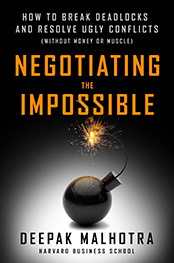 I’m excited. When I had the opportunity to view an early draft of Negotiating the Impossible: How to Break Deadlocks and Resolve Ugly Conflicts (without Money or Muscle) by Deepak Malhotra, I thought it was excellent and a great addition to any negotiator’s bookshelf. I told many of my friends and clients to watch for it. I’ve been waiting for the book to be published so I could review it.
I’m excited. When I had the opportunity to view an early draft of Negotiating the Impossible: How to Break Deadlocks and Resolve Ugly Conflicts (without Money or Muscle) by Deepak Malhotra, I thought it was excellent and a great addition to any negotiator’s bookshelf. I told many of my friends and clients to watch for it. I’ve been waiting for the book to be published so I could review it.
This is a great book. But it’s not a great book for everyone.
Who should and should not read Negotiating the Impossible
If you’re even a moderately experienced negotiator and if you’ve read a book or taken a course to help you understand how to do better, you should buy this book. It will help you understand and deal with the challenges every negotiator confronts from time to time.
If you haven’t read a good book on negotiation, don’t start with this one. Pick up one of the good basic books on negotiation. My two favorites are Herb Cohen’s You Can Negotiate Anything and Roger Fisher and William Ury’s Getting to Yes. Those aren’t the only good books out there, but they’re two that I know and use.
Things you should know before reading the book
The first thing you should know before you read the book is that Deepak Malhotra understands negotiation as a normal human activity. He uses the term “negotiation” is the broadest sense.
You should also know that there are examples from all kinds of negotiation in this book. That means that if you’re a business reader, you may have to do some work to translate an example from diplomacy, say, into your own area. I think that the author gets lost in the details sometimes. But that’s a small thing in a book this good.
One thing I really like is that the author makes no magical claims for the book. He doesn’t promise that you will win every negotiation if you buy the book or that there are “secrets” here that you’ll find nowhere else. So, don’t expect magic or secret techniques. Do expect tested, practical, tools to help you deal with difficult negotiating challenges.
The promise of the book
The title and subtitle capture the promise of the book, but there’s a more detailed promise in the Introduction. It describes when you will find the book useful and what you’ll find in its pages.
“When even your most generous offers are being rejected, when your well-intentioned attempts at addressing the issues are being thwarted, and when you have little power with which to impose a solution, you need a different approach and other sources of leverage. This book provides such an approach and reveals those sources of leverage.”
In other words, this book is for those negotiations when things seem hopeless. Malhotra offers you three “sources of leverage” that may help you meet the challenges.
The three sources of leverage
The main body of the book describes how to use three sources of leverage. While these are intended to help you when things look impossible, if you’re an experienced negotiator you’ll also find clues to how to head off trouble.
The Power of Framing
Framing is the way you structure and present your proposals. Sometimes this is more important than the content of the proposals themselves.
The Power of Process
Every negotiation is a process. The way you structure the process can be the difference between success and failure.
The Power of Empathy
Don’t think of empathy in this context as something warm and fuzzy. Malhotra discusses how you can understand the real interests and perspectives of all the players.
The Bottom Line
If you’re an experienced negotiator with a couple of negotiating books already on your shelf, this book is a must-buy, must-read, and must-use.


There are no comments yet, why not be the first to leave a comment?